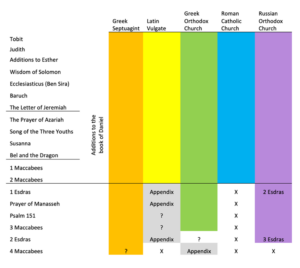The Old Testament Apocrypha comprise books, fragments of books, and alternative versions that are considered deuterocanonical by some (the Greek Orthodox Church) and “useful to read” by others (Martin Luther), but are not given Word-of-God status by the Protestant Church. “Apocrypha” means hidden and these writings are thought to be complementary at best, with good reason.
The Christian Bible Reference Site helped me to understand the sequence of events. Briefly:
- The Hebrew Scriptures were translated in the 3rd century BC, creating the Greek Septuagint.
- 15 books were written between 200 BC and 70 AD and added to the Septuagint.
- Early Christians adopted the complete set of Greek material as their Old Testament.
- Jewish leaders included only the original Hebrew Scriptures in their official canon in 100 AD.
- In the 1500s, Protestant leaders separated the 15 books into their own section, the Apocrypha, which has been omitted from Bible editions since the late 1800s.
- The Roman Catholic and Orthodox churches still base their Old Testament on the Greek Septuagint instead of the Hebrew canon, but don’t all include the same books.
Being a visual learner, I needed a diagrammatic representation of which books were included in which ancient texts, and which are accepted by which branches of the church. Perhaps the table I created will help you too (Remember, Protestant Bibles do not include any of these Apocrypha.):

I’m sure that there are scholars who have a much deeper knowledge and understanding than I do, but this table served me well when I watched Dr. David DeSilva’s symposium covering the Apocrypha on the SATS YouTube channel.
There are a number of reasons we don’t accept the Apocrypha as canonical.
- Historically speaking, these books were never endorsed by a general church council during the first four centuries of the Christian Church.
- The New Testament authors don’t ever explicitly quote these books or refer to them as Scripture. They would have had access to this material; yet, they never refer to them in the same way they do to the Hebrew text: “As it is written …”
- There are inconsistencies between what is written in the Apocrypha and what Jesus taught. Examples include praying for the dead (2 Macc 12:38–45), salvation by works (Tobit 12:9), and no mention of eternal life in Ben Sira.
That said, it may be informative (note: not instructive) for Christians to read these complementary texts. Doing so may help us to better understand:
- the era during which Jesus and the apostles lived;
- the resources available to Jesus and the Jews;
- the disagreements between Jesus and the leaders of the time;
- the challenges faced by the early Church;
- the ethics and practices of the early Church;
- how the early Church understood the Trinity;
- Saul’s motivation for his strict confinement of the Jews within the covenant made with Moses; and
- the rise of the Zealot movement.
Since some of these books are historical texts, some are wisdom literature, and others are historical fiction, when we read them, we should do so prayerfully and with discernment, mindful of their secondary importance.
Bibliography
Briones, D. 2019. “What Is the Apocrypha? Listening to four centuries of silence.” Desiring God. Accessed July, 18, 2023. https://www.desiringgod.org/articles/what-is-the-apocrypha
The Christian Bible Reference Site. n.d. “What is the difference between Protestant and Catholic bibles?” Accessed July, 19, 2023. https://www.christianbiblereference.org/faq_bibles.htm
Herbst, N. n.d. “What is the Apocrypha?” Explore God. Accessed July, 18, 2023. https://www.exploregod.com/articles/what-is-the-apocrypha
Houghton, Myron J. 2007. “Why we reject the Apocrypha.” Faith Baptist Bible College and Theological Seminary. Accessed July, 19, 2023. https://faith.edu/faith-news/why-we-reject-the-apocrypha/
Milton, Michael A. 2019. “What Is the Apocrypha and can we trust it?” Bible Study Tools. Accessed July, 18, 2023. https://www.biblestudytools.com/bible-study/topical-studies/what-is-the-apocrypha-and-can-we-trust-it.html
National Council of Churches of Christ in the United States of America. 2021. New Revised Standard Version Updated Edition (NRSVUE). Bible Gateway. Accessed July, 18, 2023. https://www.biblegateway.com/versions/New-Revised-Standard-Version-Updated-Edition-NRSVue-Bible/#booklist
St. Tikhon’s Monastery. 1986. “The Old Testament Apocrypha.” In These Truths We Hold – The Holy Orthodox Church: Her Life and Teachings. South Canaan: St. Tikhon’s Seminary Press. Accessed July, 18, 2023. https://www.stots.edu/article/The+Old+Testament+Apocrypha
Vulgate.Org. n.d. “Vulgate: The Holy Bible in Latin language with Douay-Rheims English translation.” The Latin Vulgate Bible. Accessed July, 19, 2023. https://vulgate.org/
- To watch the full symposium on the Apocrypha, follow this link.
- Contact SATS to find out more about studying God’s word.
- An article about applying intertextuality may interest you. Find it here.
- Kevin G. Smith’s article on apostolic interpretation may be helpful too.




